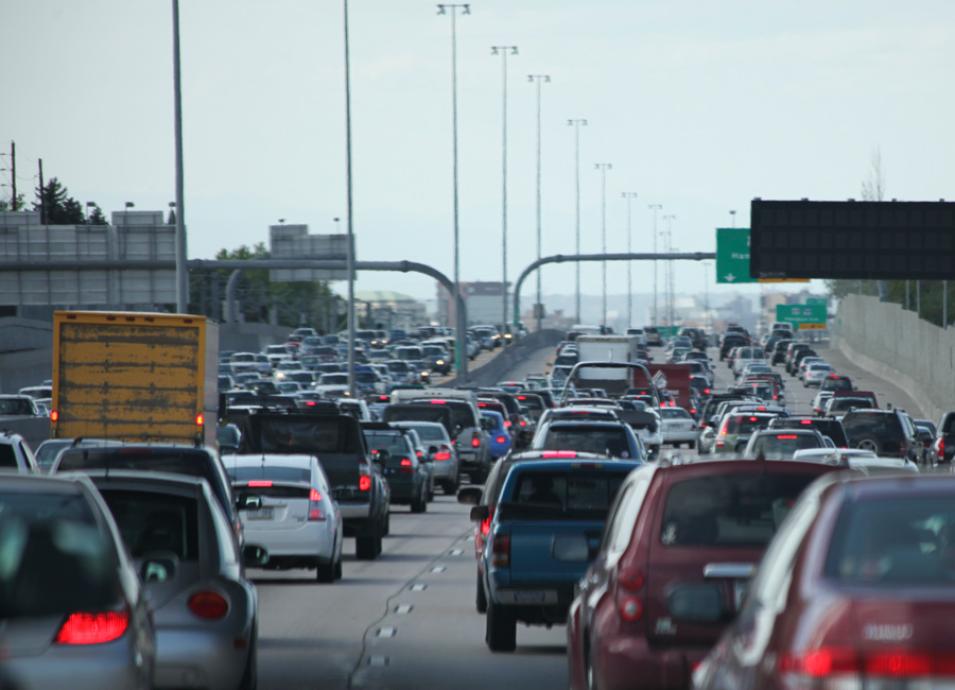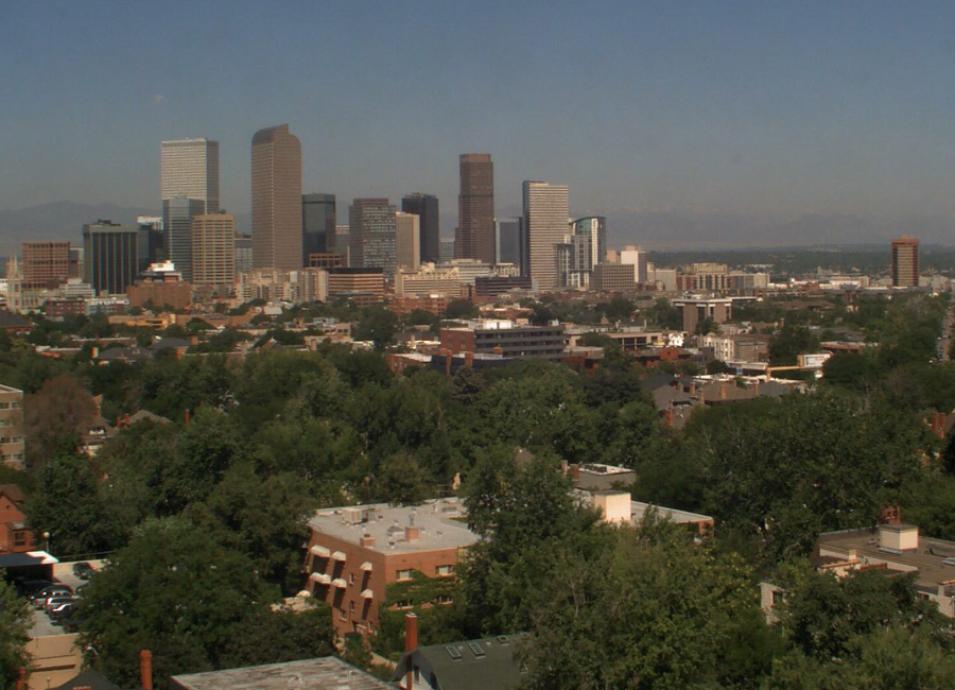Pollution has clogged Denver’s air since the 1960s. As the city’s population grew, so did a hazy layer, nicknamed the brown cloud. During the 1970s and early 1980s, Denver violated air quality standards up to 200 days a year. Since then, successful environmental campaigns and improvements in engine design have brought Denver air quality within standards, except for one pollutant: ozone. Why does ozone remain so persistent?
A Rising Problem
Denver is part of Colorado’s Front Range—a north-to-south string of cities nestled against the Rocky Mountains. Unique airflow patterns frequently trap air pollution, curdling it into a dense, visible layer. In addition, researchers have long known that Denver’s air quality problems were traveling into the mountains and nearby communities. John T. Sullivan, a NASA atmospheric physicist and postdoctoral fellow, participated in a recent campaign to better sample how air in the region circulates and how it transports pollutants. “We found evidence of a recirculating polluted air mass,” he said. “It turns out that pollutants originating near Denver do not always stay in Denver.”
Honing in on ozone
The brown cloud over Denver comes mostly from vehicles, which emit nitrogen dioxide, formaldehyde, and benzene. Some days, these noxious chemicals dissipate, whisked away by prevailing westerly winds. Other days, pollution hangs in the air. Ozone itself is not one of these emitted chemicals: it forms when emitted pollutants interact with sunlight and heat in a photochemical process that converts them into ozone.
Likewise, ozone is not what people see in the brown cloud. “A lot of the brown comes from nitrogen dioxide, and from particles created when ammonia emitted from agricultural sources to the east combines with nitric acid from the nitrogen dioxide,” said Andrew Langford, a researcher with the National Oceanic and Atmospheric Administration (NOAA). “Nitrogen dioxide is also one of the main precursors for forming ozone.” Ozone is a colorless gas, but visible haze often indicates the ingredients necessary to bake pollutants into ozone. Consequently, high ozone levels often coincide with smoggy days.
Ozone can aggravate lung conditions such as asthma and emphysema. It damages healthy lungs, can cause chronic obstructive pulmonary disease, and may be behind the increasing prevalence of asthma. The Environmental Protection Agency (EPA) began regulating ozone in 1971. By 2008, air containing more than 75 parts per billion by volume (ppbv) would exceed EPA air quality standards. In 2015, the EPA tightened the ozone standard to 70 ppbv.
Mapping the solenoid
Most cities use ground stations to monitor ozone. Single-location measurements, however, cannot capture the three-dimensional air flow that is important for understanding air quality. In Denver, for instance, prevailing winds usually breeze down the mountains and across the city toward the open plains, clearing the city’s air. But on hot summer days, heat generated by buildings and roadways combines with soaring temperatures, producing a mass of air that is warmer than surrounding areas. This warm mass forms a column of rising air, or a thermal. Along the Front Range, thermals can temporarily shift prevailing winds, sweeping air and pollution westward. “Air flow actually goes reverse of what you would normally expect, and blows back up the mountains,” Sullivan said.
In the evening, if the reverse flow is strong enough, the air often recirculates back down to Denver and other cities. Sullivan compared this flow to a solenoid, a cylindrical coil, stretching along the Front Range. Air flows clockwise, funneled high up the mountains west of Denver and spiraling northeast before circling back down over cities like Fort Collins in northern Colorado. Researchers knew that air pollution was included in this solenoid circulation. For direct evidence, they needed continuous profiles of chemical pollutants and winds during the entire recirculation event.
Sullivan and Langford participated in just such a study. For 31 days, from July 16 to August 16, 2014, a NASA P-3B aircraft flew ozone sensors over ground stations dotting the Front Range from Denver to Fort Collins. At three ground stations, researchers operated lidar instruments that were part of the Tropospheric Ozone Lidar Network (TOLNet), sending pulses of light up into the air column to measure ozone concentrations. The aircraft would ascend or descend in a tight spiral over each station, gathering data vertically along the entire air column as the station instruments recorded. Ozonesondes, or balloon-borne instruments, were launched to help with lidar validation and analysis.
Sullivan and his team operated the lidar instrument at the Fort Collins site as part of the NASA Deriving Information on Surface Conditions from Column and Vertically Resolved Observations Relevant to Air Quality (DISCOVER-AQ) campaign, which was conducted in conjunction with the National Science Foundation Front Range Air Pollution and Photochemistry Experiment (FRAPPÉ). Langford and his team from NOAA operated a lidar station at the Boulder Atmospheric Observatory, located between Denver and Fort Collins. A third NASA lidar operated in Golden, west of Denver. These stations required round-the-clock diligence. Langford said, “Our laser system is finicky enough that while a lot of the activities are automated, the whole system is not autonomous, and people have to be there with it all the time.” This nonstop effort was critical for gaining uninterrupted data mapping flow along the entire air column. Sullivan said, “That’s why ozone lidar is really valuable, because we were able to, throughout the entire day, see the time record of ozone at the surface as well as aloft.”
A week into the study, the morning of July 22 started out clear and cool, with winds out of the west. Temperatures soon sizzled at 96 degrees Fahrenheit, and by early afternoon, a thermal began rising up the foothills. From afternoon into evening, the researchers caught the solenoid in action, swooping Denver’s air—and its pollution—up the mountains, high into the atmosphere, and swirling back down over Fort Collins. That day, out of the 17 Front Range sites the campaign monitored, three exceeded EPA 2008 ozone standards, including Fort Collins. Six sites would have violated the stricter 2015 standards. “The ozone lidar verified a return flow much later in the day, which corresponded to increases at many of these sites,” Sullivan said. “It’s very obvious evidence that we’re getting a return flow of this polluted air mass that impacts surface conditions.”
Under certain conditions, upslope flow (orange arrows) draws air from the plains, across the Colorado Front Range. This airflow sweeps pollutants from Denver upwind toward the foothills where they accumulate (red arrows) at higher elevations. This elevated flow (purple arrows) interacts with westerly winds (green arrows) and recirculates slightly north and back downward. The polluted air (blue arrows) can then mix downward over the Front Range. (Courtesy J. T. Sullivan, et al., 2016, Journal of Geophysical Research: Atmospheres)
Factoring in the fold
Denver’s ozone problem also has more distant sources. A thin ozone layer sits high in Earth’s atmosphere, at least 10 kilometers (6 miles) in altitude. This far from the surface, ozone forms a protective layer, shielding the planet from ultraviolet sunlight. Certain atmospheric conditions can force tongues of this naturally-occurring ozone to fold down, intruding into the atmospheric layer near Earth’s surface, and depositing yet more ozone at the ground level. These descending tongues are more likely to reach high altitude regions, making the high deserts of southwestern United States and mountains of Colorado a hot spot for intrusions. Langford said, “These regions have more frequent deep intrusions than any other place in the world except the Tibetan Plateau.”
Making matters worse, folds of intruding ozone can recirculate pollution from elsewhere. “It can bring down with it transported pollution from Asia, either from industrial sources or from wildfires in Siberia, for example,” Langford said. Pollution included in these folds contributes to background ozone, levels that would exist regardless of local sources. These higher background levels affect air quality in cities like Los Angeles, Las Vegas, and Denver. “If you’ve got background levels of 50 to 60 ppbv, and the standard is at 70, that’s not a lot of room for additional production,” Langford said. “That’s the challenge much of the West is facing.”
Sullivan, Langford, and their colleagues continue to operate lidar instruments at campaigns across the United States and around the world to help researchers understand why some areas still struggle with air pollution. Multiple agencies coordinate the labor-intensive campaigns between flight teams and ground crews. Langford said, “We really tie together interactions between NOAA, NASA, and the EPA on this problem. The synthesis of using information from a lot of different sources, and getting the agencies working together is very powerful.”
Although city officials continue to rely on surface monitoring, campaigns like this help them account for regional circulation patterns. Air quality managers can incorporate this three-dimensional airflow into models normally based on ground measurements, refining their ability to understand and predict poor air quality. This is especially true for a city like Denver that has high background levels of ozone coupled with airflow patterns that recirculate pollution. Sullivan said, “The vertical profile is really one of the key measurements needed in understanding the complexities of pollution formation and transport.”
Between noon and 9:00 p.m. on July 22, 2014, ozone concentrations increased over the Fort Collins study site. Concentrations peaked late in the evening, after daytime pollution from the Denver area recirculated into the Fort Collins region. Red, orange, and black indicate concentrations that violate ozone level standards set by the Environmental Protection Agency. (Courtesy J. T. Sullivan, et al., 2016, Journal of Geophysical Research: Atmospheres)
References
DISCOVER-AQ Science Team, Hampton, VA, USA: NASA Atmospheric Science Data Center (ASDC). doi:10.5067/Aircraft/DISCOVER-AQ/Aerosol-TraceGas.
Sullivan, J. T., T. J. McGee, A. O. Langford, et al. 2016. Quantifying the contribution of thermally driven recirculation to a high-ozone event along the Colorado Front Range using lidar. Journal of Geophysical Research: Atmospheres 121: 10,377–10,390. doi:10.1002/2016JD0252229.
TOLNet Science Team. 2013. Tropospheric Ozone Lidar Network (TOLNet) Ozone Observational Data. NASA Langley Atmospheric Science Data Center DAAC. doi:10.5067/lidar/ozone/tolnet.
For more information
NASA Atmospheric Science Data Center (ASDC)
Deriving Information on Surface Conditions from Column and Vertically Resolved Observations Relevant to Air Quality (DISCOVER-AQ)
Front Range Air Pollution and Photochemistry Experiment (FRAPPÉ)
Tropospheric Ozone Lidar Network (TOLNet) Data and Information
| About the data | ||
|---|---|---|
| Platforms | NASA P-3B | Tropospheric Ozone Lidar Network (TOLNet) |
| Sensors | Various | Ozone lidars |
| Data sets | Deriving Information on Surface Conditions from Column and Vertically Resolved Observations Relevant to Air Quality (DISCOVER-AQ) | TOLNet 03 Surface Photometer data |
| Parameters | Aerosols, aerosol backscatter, trace gases/trace species, air quality | Aerosols, aerosol backscatter, trace gases/trace species, air quality |
| DAAC | NASA Atmospheric Science Data Center (ASDC) | NASA ASDC |



